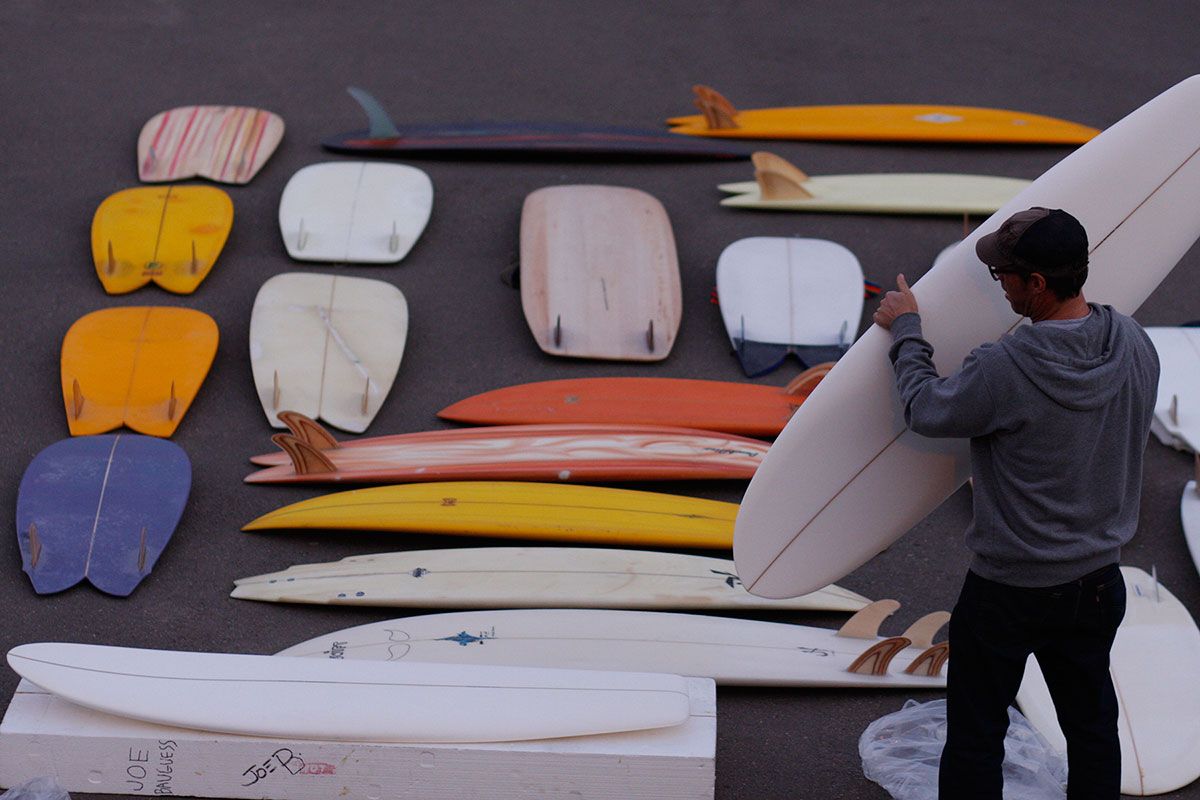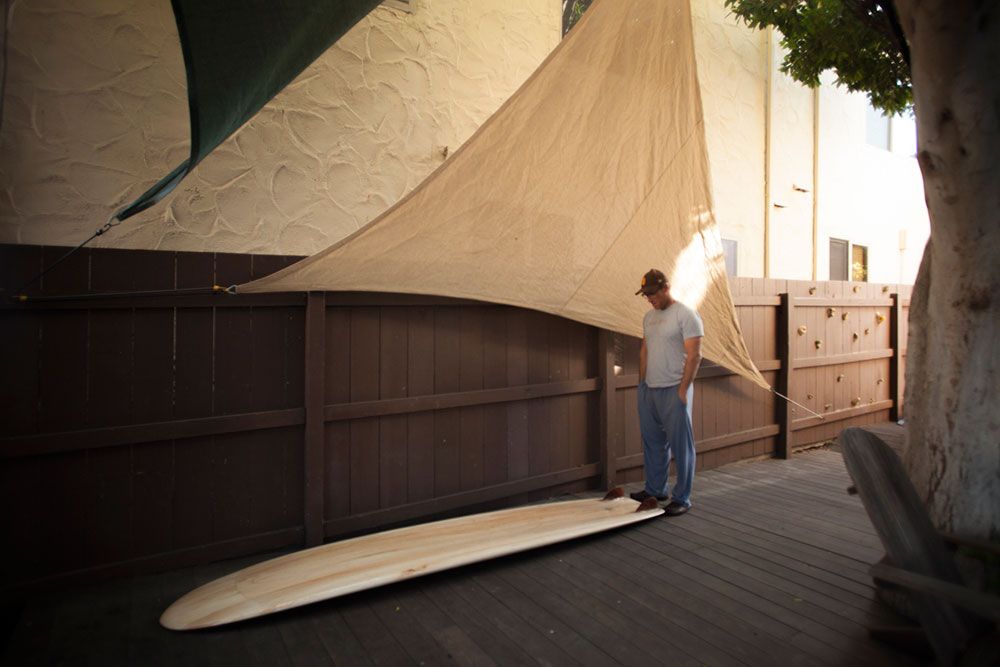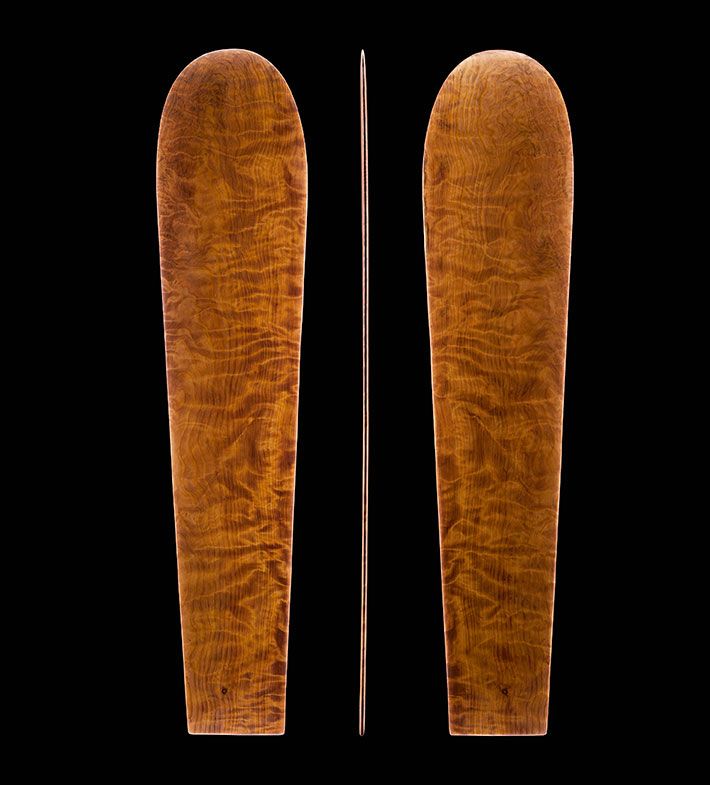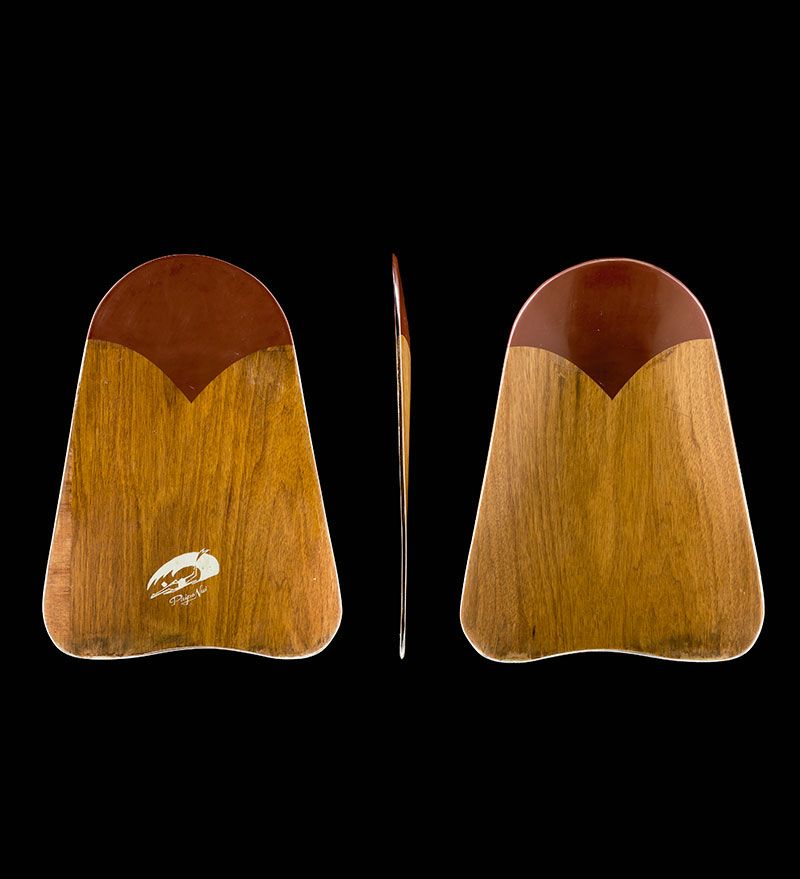Un famoso refrán japonés afirma que lo último a lo que presta atención un pez es al agua que lo rodea cada día. Esta frase encierra una sabiduría ancestral milenaria y también podemos aplicarla a las cosas cotidianas de nuestro entorno, puesto que su belleza queda siempre escondida detrás de la rutina, el aburrimiento y la cotidianeidad. Richar Kenvin, surfista veterano y apasionado de la cultura de las olas, se dio cuenta de que el comercialismo actual ha relegado el diseño tradicional de tablas de surf a un segundo plano y que éstas casi ya no despiertan admiración porque han desaparecido de las playas de medio mundo. El descubrimiento de la manera de ver el mundo del filosofo japonés Yanagi le hizo ver que era necesario preservar la tradición artesana que había nacido en California después de la II Guerra Mundial y relacionarla con el fenómeno del surf para preservarlo para las próximas generaciones. Esto le llevó a localizar y fotografiar cientos de tablas añejas para ilustrar un fabuloso libro titulado “Surf Craft”. Ahora hemos tenido la oportunidad de entrevistarlo para descubrir los entresijos de esta aventura que tanto bebe del mundo del surf como de las ideas orientales más tradicionales, al mismo tiempo que nos presenta unas imágenes de belleza eterna y a todo color.

(1)
Remontémonos a los inicios de tu pasión por las olas. ¿Podrías contarnos cuándo y dónde empezaste a practicar surf?
En Blacks Beach (San Diego, California) en agosto de 1970 junto a mis amigos Colin Brown y Ben Bridgman. Entonces Colin y Ben ya eran buenos surfers.
¿Recuerdas cuál fue tu primera tabla?
Mi primera tabla fue una RoundtaIL single fin Atlantis 6’0” de color rojo hecha por Dan Bridgman, que curiosamente es el hermano mayor de mi amigo Ben y además es surfista local de Blacks.

(1)
¿Con qué tablas seguiste persiguiendo tu pasión por el océano?
Mi siguiente tabla fue una 3 Stringer Yellow Tint 5’10” Diamond Tail single fin hecha por Paul Bridgman, el otro hermano mayor de Ben que también es un local de Blacks. Se trataba de una custom fabricada en su garaje en Starlight Drive cerca de La Jolla. Conseguí el “blank” gracias a Mitch en el Mitch’s Surf Shop de La Jolla, que ra y aún es el gran proveedor de foam y de material para los shapers locales que trabajan en los jardines de su casa. Eso fue en 1972 y entonces me aficioné a las tablas y supe cómo quería que fuera mi surf gracias a los hermanos Bridgmans, Colin Brown, Gary Keating, Tim Lynch, Henry Hester y los tíos de Windansea Chris O’Rourke, Mark Brolowski, Ted Smith, Brew Briggs y Tim Senneff. Rusty Preisendorfer fue quien cogió el relevo y empezó a fabricar mis tablas en 1974, incluso fue una gran influencia en mi surf desde entonces hasta los años 90. También Bill Caster en el período 1980 – 1986.
¿Cómo te adentraste en el diseño y la fabricación de tablas?
Me metí de lleno en el diseño de tablas a partir de investigar y también cogiendo olas con tablas diseñadas por Steve Lis y Bob Simmons. Además de réplicas de tablas hawaianas tradicionales (alaias) hechas por Jon Wegener.

(1)
Por curiosidad, ¿cómo descubriste a Bob Simmons y sus famosos diseños?
Cuando era un crío, todos escuchábamos historias sobre Simmons ahogándose y que quedó atrapado en una de las cuevas submarinas en Simmons Reef. Esas leyendas no eran verdad, pero fueron las primeras cosas que escuché sobre él. He pasado la mayor parte de mi vida practicando surf en el mismo trozo de océano donde Simmons murió, así que siempre fue alguien muy presente. Entonces, cuando era adolescente, trabajaba limpiando platos en el Chart House de La Jolla y allí había una vieja tabla de Simmons colgada en la pared. Parecía muy pesada y nunca logré imaginarme cogiendo olas con ella. En 1995, cuando ya estaba en la treintena, leí el artículo de John Elwell titulado “The Enigma of Simmons” para Surfer’s Jornal. Mirando esas fotos y leyendo sobre ese personaje intenté comprender sus tablas, pero todavía era algo que se escapaba de mi entendimiento. Y nunca me planteé usar una de ellas. Coger olas con “fish boards” y ver si Steve Lis tuvo una conexión con Simmons fue lo que realmente me hizo adentrarme más en su trabajo. Pensé que Lis había estado influenciado por las tablas de Simmons, pero no lo estaba y llegó a la “fish” de manera independiente. Pero esa tabla se nutre de la misma técnica hidrodinámica que las de Simmons. En aquellos días de 2003 conocí a John Elwell y él compartió conmigo todo lo que sabía de Bob Simmons. Resulta que John vivía a sólo 5 minutos de mi casa y nos veíamos mucho. Recuerdo que tenía una réplica de Simmons y dejó que la utilizara, así fue como empecé a comprender los diseños de Simmons. Todo se resume en hablar con John y coger olas con esa tabla.

Newman Big Rock Stinger. (2)
¿Cuál es la historia detrás de “Surf Craft”?
El libro “Surf Craft” se basa en un espectáculo que produje para el Mingei Museum de San Diego. Mingei es una filosofía basada en la estética y la artesanía que empezó en Japón hace casi un siglo. Su propósito es preservar, venerar y asegurar la continuación de la artesanía tradicional en una época marcada por la producción en cadena. El filósofo e historiador del arte japonés Soetsu Yanagi fundó este movimiento cuando inventó la palabra “mingei” que significa “el arte de la gente” en 1918. Yanagi evolucionó hasta establecer el Nihon Mingeikan Museum (algo así como el Museo Japonés de la Artesanía Folk) en Tokio en 1936. La frase “nihon mingeikan” significa “el arte de la gente que retorna a la misma gente”. Yanagi fue un escritor muy prolífico y desarrolló una filosofía muy asombrosa basada en la artesanía en oposición al mundo industrializado. Sus escritos se recopilaron gracias a uno de sus discípulos, Bernard Leach, y acabaron publicándose en un libro titulado “The Unknown Craftsman” en 1972.

Mini Simmons Casper. (2)
¿Qué puedes contarnos sobre tu acercamiento a la filosofía Mingei?
Mi conocimiento de Mingei relacionado con las tablas de surf empezó en 2004 cuando conseguí una copia de “The Unknown Craftsman” en la tienda de regalos del Mingei International Museum en San Diego. Después de leerlo me di cuenta de que su filosofía proporcionaba un marco único a partir del que apreciar el valor de todos los aspectos relacionados con la artesanía, el diseño y el uso te tablas de surf. En “The Unknown Craftsman” Yanagi divide la artesanía en tres categorías: mingei (folk), artesanía artística y artesanía industrial. La artesanía mingei consiste en objetos anónimos, útiles, hechos a mano y pensados para la vida diaria. Yanagi lo consideraba la expresión más pura de la creatividad humana. Una “paha” tradicional de Hawái (paipo), también conocida como “alaia” es una de las primeras tablas hechas de madera de balsa que responden a los ejemplos de la artesanía mingei en el más puro sentido del término. Después viene la artesanía artística que está diseñada por un creador y que llama la atención por sus habilidades, su técnica y la fama del individuo que lo ha hecho. Con esta modalidad el artista empieza a eclipsar al objeto. Una tabla actual hecha a mano y customizada por un shaper famoso es un buen ejemplo de este tipo de artesanía. La última categoría es la artesanía industrial y, como su nombre indica, se inscriben dentro de los procesos industriales mediante maquinaria. En estos casos los objetos tienen marca y destacan por la línea de producción en lugar del creador individualizado. La mayoría de tablas que se producen hoy en día son una mezcla de artesanía artística e industrial en mayor o menor medida.

Hendrix Fluid Systems Experimental. (2)
¿Cómo explicarías el proceso de fotografiar todas esas tablas? Da la impresión de que ha sido una tarea monumental…
Todo eso sucedió gracias a Ryan Field puesto que se animó a fotografiar todas las tablas de hidrodinámica. Él ya había fotografiado tablas anteriormente, pero siempre lo hacía con luz natural. Entonces, para el artículo que escribí sobre los hermanos Mirandon en 2006 / 2007, él fotografió algunas Twin Pins y alquiló un equipo de luces, pero lo hicimos en la calle de su casa y seguía siendo algo amateur. Yo me escondía detrás de las tablas y las aguantaba mientras él hacía las fotos. Así que Ryan tuvo la idea de cómo iluminar y retratar las tablas para que fuera más efectivo y consistente, así que me preguntó si podía construir una estructura para las luces en mi loft de la Calle 16. Yo le dije que no había ningún problema y le ayudé a montar todo eso con maderas. Literalmente conduje miles de kilómetros para encontrar las tablas que fotografiamos y cada vez aparecían más. Ryan es muy responsable y sus fotos son muy buenas. Nunca se habían fotografiado tablas de surf de ese modo. Todo eso lo montamos para Hydrodynamica, pero cuando apareció el libro Mingei decidimos usar algunas de esas imágenes para el libro “Surf Craft”.

Frye Whitefish. (2)

Ekstrom Finless. (2)

Cove Bturn ReplicaJS. (2)

(1)

Alva & Richard. (1)

Alva & Richard. (1)

(1)

(1)

Simmons Gun replica

(2)

(2)


(2)

Stone Redwood Omo. (2)

Simmons Sandwich Dual Fin Concave. (2)
(ENGLISH)
RICHARD KENVIN.
“SURF CRAFT”: SURF BOARDS CRAFTWORK
A well-known japanese proverb says that the last thing a fish pays attention to is the water that surrounds them every day. This sentence contains an ancestral wisdom that can be also applied to the daily things in our environment, since its beauty is always hidden behind the boredom and the daily routine. Richard Kenvin, veteran surfer who’s passionate about the waves culture realized that the current consumerism has pushed the traditional surf board design to the background and that they almost don’t inspire admiration anymore, since they have disappeared from the beaches around the world. Discovering the philosophy of japanese art historian and philosopher Yanagi made him realize that it was necessary to preserve the artisan tradition that had emerged in California after the Second World War and to relate it to the surf phenomenon in order to preserve it for future generations. All this led him to locate and photograph hundred of old boards in order to illustrate a fantastic book named “Surf Craft”. We had the chance to interview him and find out the hidden details of this adventure that, inspired by the surf world and the traditional oriental ideas, showcases full color images of eternal beauty.
When and where did you start surfing?
I started at Blacks beach in San Diego, California in August 1970 together with my friends Colin Brown and Ben Bridgman. Colin and Ben were already surfers.
What was your first board?
My first board was a red 6’0’’ roundtail single fin “Atlantis”, made by Dan Bridgman (Ben’s older brother, who was an original Blacks local)
What were the next following boards that established your feel for the ocean?
My next board was a 3 stringer yellow tint 5’10’’ diamond tail single fin made by Paul Bridgman, Ben’s older brother who was also an original Blacks local. This was a custom board made in the Bridgman garage on Starlight Drive in La Jolla. I got the blank from Mitch at Mitch’s Surf Shop in La Jolla, who supplied (and still supplies) backyard shapers with foam and materials. This was in 1972. I got a feel for boards and how I wanted to surf from the Bridgmans, Colin Brown, Gary Keating, Tim Lynch, Henry Hester, and Windansea guys Chris O’Rourke, Mark Brolowski, Ted Smith, Brew Briggs and Tim Senneff. Rusty Preisendorfer started making my boards starting in about 1974 was a big influence on my surfing from then through the nineties. Also Bill Caster from 1980-86.
How did you get interested in surfboard design?
I got into board design from researching and riding boards designed by Steve Lis and Bob Simmons, and replicas of traditional Hawaiian boards (“alaias”) made by Jon Wegener.
How did you come across Bob Simmons and his designs?
When I was kid we all heard stories about Simmons drowning, that he got trapped in one of the underwater caves at Simmons reef. Those stories weren’t true, but it was the first I heard of Simmons. I’ve spent most of my life surfing over the patch of ocean where Simmons died, so he was always a presence. Then when I was a teenager I washed dishes at the Chart House in La Jolla and there was an old Simmons board hanging in there. It was so monolithic I never even imagined surfing on it. Then in 1995, when I was in my thirties I read John Elwell’s article “The Enigma of Simmons” in the Surfer’s Journal. Looking at the photos and reading about Simmons made me try to understand the boards, but it was still all way out in outer space for me, and I didn’t think about actually riding one. Riding fish boards and seeing if Steve Lis had a connection to Simmons was what really made me dig deep into Simmons. I thought maybe Lis had been influenced by Simmons boards, but he wasn’t, he came up the fish independently. But the fish works off the same hydrodynamic stuff as the Simmons board. During that time, in 2003, I met John Elwell. He shared everything he knew about Simmons with me. It turned out he lived 5 minutes away from me, so I saw him a lot, I still do. He had a Simmons replica he let me ride it, and that’s how I began to understand what Simmons design was all about, by talking to John and by surfing on Simmons boards.
How did SURF CRAFT come about?
The book “SURF CRAFT” is based on a show that I produced for the Mingei Museum in San Diego. Mingei is an aesthetic and craft philosophy that began in Japan nearly one hundred years ago. Its purpose is to preserve, revere and ensure the continuation of traditional handcrafts in the age of mechanized mass production. Japanese art historian and philosopher Soetsu Yanagi instigated the movement when he coined the term “mingei”, which means “art of the people” in 1918. Yanagi went on to establish the Nihon Mingeikan Museum (aka “Japan Folk Craft Museum) in Tokyo in 1936. The phrase “nihon mingeikan” stands for “art of the people, returned to the people.” Yanagi was a prolific writer, and he developed a compelling philosophy on all aspects of handcraft in relation to the industrialized world. These writings were compiled by one of his disciples, Bernard Leach, and eventually published in a book titled “The Unknown Craftsman” (1972).
How did you find out about Mingei?
My awareness of mingei as it relates to surfboards began in 2004, when I bought a copy of “The Unknown Craftsman” from the gift shop at the Mingei International Museum in San Diego. After reading it, I realized the mingei philosophy provided a uniquely appropriate framework with which to appreciate and value all aspects of the craft, design, and use of surfboards. In “The Unknown Craftsman”, Yanagi divides crafts into three broad categories: mingei (or folk) crafts, artist crafts, and industrial crafts. Mingei crafts are anonymous, useful, handmade objects intended for daily life. Yanagi considered these the purest expression of human creativity. A traditional Hawaiian paha (paipo) or alaia board, an early hot curl board, or unsigned boards from the balsa era are examples of mingei craft in the purest sense of term. Next come artist crafts, which are signed by their maker, calling attention to the skills, stylized techniques, and fame of the individual who made them. With artist crafts the maker begins to eclipse the object. A hand-shaped, custom surfboard made today by a famous shaper is an example of an artist craft. The final category is industrial crafts. These are made within the industrial system by mechanical means. Industrial crafts are branded, calling attention to a product line instead of an individual maker. Most “production” surfboards built today are a blend of artist craft and industrial craft, to a greater or lesser degree.
What was the process of photographing all those boards like. It seems like an enormous undertaking!
That came about because Ryan Field was inspired to shoot all the hydrodynamica boards. He shot some boards before, but we were always doing it in natural light. Then for the article I wrote on the Mirandon brothers in 2006/2007, he shot some Twin Pins, and rented lights, but we did it on the driveway of his house. It was still pretty seat of the pants. I’d hide behind the boards and hold them while he shot them. Ryan had an idea of how to light and shoot the boards that would be effective and consistent, so he asked me if he could build his lighting structure in the loft there on 16th street. I helped get all the wood and materials and Ryan built this crazy lighting apparatus in the loft. It is still there. I drove literally thousands of miles to get boards that were photographed, and we are still photographing more. Ryan is very dedicated and his photos are amazing, boards were never photographed that way before. It was all done for Hydrodynamica, but when the Mingei book came along we decided to use some of the images for the “Surf Craft” book.
How did the Hydrodynamica movement come about?
In December 2002 I rode a fish for the first time in twenty-five years and that’s when it really clicked: that there was a history here that I wanted to look into and a story I wanted to tell. But the thing that really clinched it, though — and this is very random — was Reno Abellira showing up out of the blue at Windansea. I think he was on the lam or something from Hawaii. I’d never met Reno but he was like one of my childhood heroes. My brother always emulated his surfing style and he was this huge figure to us. And Reno ended up moving into my brother’s spare bedroom in his house in Claremont. So those two guys were suddenly living together and I took this as a major sign — like, okay, that’s way too freaky: Reno’s living with my brother. I had already decided to start documenting the history I was interested in and I knew that I wanted to interview people. And Reno had been on the top of my list. He grew up riding and making paipos. He made the shortboard that had a huge influence on Mark Richards and the board that he rode in, I think, the 1976 Coke contest in Australia. And he turned out to be the first person I interviewed. I thought it would take me years to get to him. So, it really all started with Reno Abellira.
What is your take on Hydrodynamica?
Here’s a family of boards — what I refer to as planing totems — that are related to each other and can all be traced back to ancient or semi-ancient Hawaiian boards: finless, widetail, super thin and straight railed. The alaias at the Bishop Museum in Honolulu are a good example. And then you have the dual-fin planing hull that Simmons developed in the 1950s. And, still later, the Steve Lis fish. All of these boards are going to work differently but they all belong to the same family. They’re also going to do a lot of the same things. And they’re going to go really fast. From my perspective, status quo boards like the classic D-fin longboard are not part of that history. There are boards that fit in with the family and there are other boards that don’t. Together, they emerge as a parallel history and a parallel universe of surfing and board design. I was also really interested in how these boards relate to early skateboarding and snowboarding.
Where is it now and where is it headed to?
Right now I’m working with Tomo a bit, he lives in the loft now, down the street, and I live in my house nearby. He’s in Oz this month and he travels about 7 months of the year. I have all the Hydrodynamica film content here at the house, we’ve been reshooting some stuff and reloading some tapes, reorganizing everything. I hang out with Ekstrom once or twice a week, and I’ve been riding new boards by Carl, Burch, and Tomo. I’ve also been riding the FireWire Tomos a lot. I’m doing a smaller version of the Surf Craft exhibit at the Longhouse Museum in Montauk this summer, it opens on July 31st and will be up through October, so I’m working on that. As far as where the Hydrodynamica project influence is heading, its pretty much in the hands of Ryan Burch and Daniel Thomson. Those guys are both out there shaping, designing, and surfing all over the world, and they both have great support now and sponsorship. So right now Ryan is in Angourie with Bryce Young, and Daniel has been at home in Lennox hanging out with Kelly Slater. Kelly has been surfing some of Dan’s newer boards for the past few weeks. So we’ll just have to sit back and watch where these guys go with this stuff.
SURFCRAFT
HYDRODYNAMICA